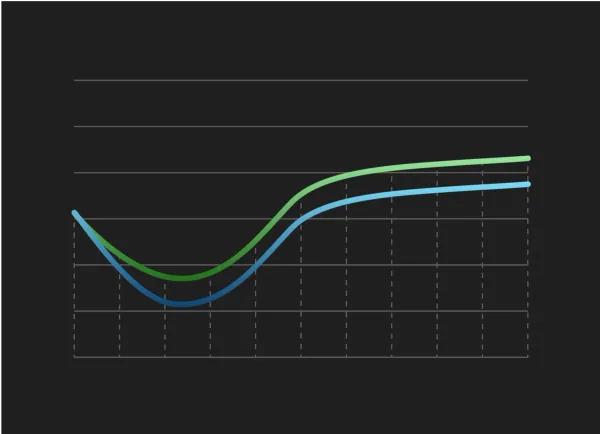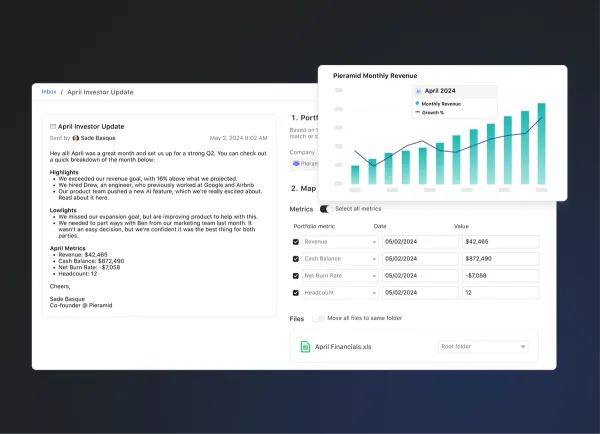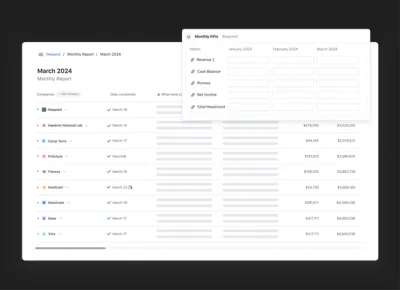
What is Internal Rate of Return (IRR) in Venture Capital

Internal rate of return (IRR) for VCs is the expected annualized return a fund will generate based on a series of cash flows over the duration of the fund, which is typically ten years. Unlike fund metrics such as RVPI, TVPI, and DPI, which are based on multiples, IRR takes into account the time value of money. IRR can be used to measure both fund performance and the performance of an individual investment.
Related Resource → VC Fund Metrics 101
What makes IRR hard to predict in a fund context is cash flows happen at irregular periods because capital calls are made by funds on an as-needed
How Is IRR Used by LPs
IRR is a critical metric for Limited Partners (LPs) in venture capital, helping them make informed investment decisions by benchmarking a fund’s performance against its peers. By considering the time since the initial cash outflow and comparing it against similar funds in the same asset class, LPs can assess the efficiency and profitability of their investments.
IRR's significance lies in its ability to account for the time value of money, providing a more nuanced view of an investment's potential returns over time. This makes it an invaluable tool for evaluating both short-term and long-term fund performance. For example, an LP might use IRR data to compare the performance of different funds launched in the same year, helping to identify which fund managers consistently deliver higher returns.
Cambridge Associates is a well-known resource that publishes quarterly benchmarks and statistics, compiling data from thousands of fund managers and their funds. These benchmarks allow LPs to compare their fund’s IRR against a broad spectrum of data, ensuring they have a comprehensive understanding of their fund's performance relative to the market. You can check out their reports here on the Cambridge Associates website.
In practical terms, an LP might look at the IRR of a prospective fund to decide whether to commit capital, comparing it against the IRRs of existing funds in their portfolio and the broader market. For instance, if a new fund has an IRR significantly above the median benchmark provided by Cambridge Associates, it might be seen as a more attractive investment opportunity.
How Is IRR Calculated for Venture Capital Funds?
Wrapping your head around the IRR formula can quickly put your brain in a pretzel so it’s recommended to use Excel, Google Sheets, or a platform like Visible to calculate IRR.
In the IRR equation below, we’re solving for the discount rate (or the expected compound annual rate of return) that makes the net present value of an investment zero.
IRR is calculated by solving for the rate of return (“r”) of a series of cashflows (“C”) over a period of time (“n” to the total number of periods “N”):

Accurate cash flow data is crucial in calculating IRR because even small errors can significantly affect the result. For venture capital funds, it’s essential to meticulously track all cash inflows and outflows. This includes capital calls, management fees, expenses, and distributions to LPs. Using platforms like Visible can streamline this process by providing tools to automate and track these cash flows accurately.
Check out this article for an example calculation of IRR within the fund context.
IRR vs. CAGR
While IRR and CAGR (Compound Annual Growth Rate) are both metrics used to evaluate the performance of investments, they serve different purposes and are calculated differently. Understanding these differences is crucial for investors when analyzing investment returns.
What is CAGR?
CAGR stands for Compound Annual Growth Rate and measures the mean annual growth rate of an investment over a specified period longer than one year. It provides a smoothed annual rate of return, assuming that the investment grows at a consistent rate each year.
CAGR is particularly useful for comparing the historical performance of investments over time, as it neutralizes the effects of volatility and provides a straightforward percentage growth rate.
Key Differences Between IRR and CAGR:
1. Consideration of Cash Flows:
- CAGR assumes a single investment and does not account for intermediate cash flows. It provides a geometric mean return over the period.
- IRR, on the other hand, takes into account the timing and magnitude of all cash flows, including intermediate inflows and outflows, providing a more detailed picture of the investment's performance.
2. Calculation Complexity:
- CAGR is simpler to calculate as it only requires the beginning value, ending value, and the number of periods.
- IRR is more complex, involving iterative calculations to find the rate that sets the NPV of all cash flows to zero.
3. Reinvestment Assumption:
- CAGR does not make any assumptions about reinvestment rates. It purely reflects the compounded annual growth rate.
- IRR assumes that interim cash flows are reinvested at the same rate as the IRR, which can sometimes be unrealistic.
4. Application Context:
- CAGR is often used to compare the performance of investments, funds, or portfolios over time, providing a clear picture of historical growth.
- IRR is widely used in capital budgeting and private equity/venture capital to evaluate the profitability of individual projects or investments, considering the specific timing of cash flows.
IRR vs. ROI
While IRR and ROI (Return on Investment) are both crucial metrics for evaluating the performance of investments, they serve distinct purposes and are calculated differently. Understanding these differences is key for investors when analyzing their investments.
What is ROI?
ROI stands for Return on Investment and measures the gain or loss generated on an investment relative to its initial cost. It is a straightforward metric that indicates the efficiency and profitability of an investment.
Key Differences Between IRR and ROI:
1. Consideration of Time:
- ROI does not account for the time value of money. It provides a snapshot of profitability without considering how long the investment was held.
- IRR incorporates the time value of money, giving a more accurate reflection of an investment's performance over time by considering the timing of cash flows.
2. Calculation Complexity:
- ROI is easy to calculate and understand, making it a popular choice for quick assessments of investment performance.
- IRR is more complex, requiring iterative calculations to find the rate that sets the net present value of all cash flows to zero.
3. Reinvestment Assumptions:
- ROI does not make any assumptions about reinvestment of returns.
- IRR assumes that interim cash flows are reinvested at the same rate as the IRR, which can sometimes be unrealistic.
4. Application Context:
- ROI is often used for short-term investments and simple comparisons. It is particularly useful for evaluating the overall profitability of different investments without delving into the timing of returns.
- IRR is widely used in capital budgeting and private equity/venture capital to evaluate the profitability of projects or investments with multiple cash flows over time.
Defining VC Fund Cash Flows
Understanding the cash flows of a VC fund is crucial for accurately calculating metrics like IRR. The timing and magnitude of these cash flows significantly impact the fund's overall performance. Let’s delve into the types of cash flows in VC funds, their timing, and their implications for IRR.
Cash Outflow Examples
Capital Calls: These are requests by the VC fund to its LPs to provide a portion of the committed capital for specific investments. For example, if a fund decides to invest $1 million in a startup, it might issue a capital call for $1 million from its LPs. The timing of these calls is crucial; delaying capital calls can enhance IRR by reducing the time period over which the capital is invested.
Management Fees: Typically, VC funds charge annual management fees, often around 2% of the committed capital. For instance, a $100 million fund might charge $2 million annually to cover salaries, operational costs, and other expenses. These fees reduce the net returns to LPs, impacting the net IRR.
Fund Expenses: These include legal fees, administrative costs, and technology expenses. For example, a fund might incur $100,000 annually in legal and administrative fees, which also affect net returns. These expenses are necessary for the day-to-day operations of the fund but reduce the overall returns available to LPs.
Cash Inflows Examples
Distributions: These are returns to LPs from the fund's investments, usually following a liquidity event such as an acquisition, merger, or IPO. For example, if a portfolio company is acquired for $10 million, the proceeds distributed to LPs constitute a cash inflow. Early and large distributions can significantly boost IRR.
Dividends and Interest: Occasionally, portfolio companies might pay dividends or interest on convertible notes. For example, a company might distribute $50,000 in dividends annually to the VC fund, contributing to cash inflows. These payments can provide a steady stream of returns, enhancing the IRR by providing earlier cash flows.
Impact of Timing on Cash Flows:
The timing of cash flows is critical in calculating IRR. Here’s why:
- Early Distributions: Receiving returns early in the fund's life can significantly enhance IRR because it reduces the period over which the capital is at risk and increases the annualized return. For instance, an early exit that returns capital within the first three years can result in a much higher IRR compared to a similar exit occurring in year seven.
- Delayed Capital Calls: By calling capital only when necessary, funds can avoid having large sums of uninvested capital, which would otherwise result in a lower IRR due to what is known as "cash drag." For example, if a fund delays a $1 million capital call by two years, it improves IRR by reducing the period the capital is deployed.
- Lumpy Cash Flows: Venture capital investments often result in irregular, or lumpy, cash flows. Large inflows from a significant exit can cause IRR to spike, while periods with no inflows might show a temporary decline in IRR. Managing these irregularities is a key challenge for fund managers.
Examples and Implications for IRR:
- Example 1: A VC fund invests $2 million in a startup and exits three years later with a $10 million return. The IRR calculation will consider the initial $2 million outflow and the $10 million inflow three years later, likely resulting in a high IRR due to the substantial gain over a relatively short period.
- Example 2: Another fund might make smaller, incremental investments over time, leading to multiple capital calls and varied exit timings. If these exits are delayed, the IRR might be lower compared to a fund with early, significant exits.
Want to learn more about tracking key fund metrics in Visible?
Gross vs Net IRR
When evaluating a venture capital fund's performance, it's essential to understand the difference between Gross IRR and Net IRR. Both metrics provide insights into the fund's returns, but they account for different factors and expenses, offering distinct perspectives on performance.
Gross IRR:
Gross IRR represents the annualized rate of return on an investment before deducting any fees or expenses. This metric focuses solely on the performance of the fund's investments, providing a measure of the raw investment skill of the fund managers.
For example, if a fund invests $1 million and it grows to $2 million over three years, the Gross IRR calculation would not consider management fees, carried interest, or any other expenses incurred by the fund. This gives an unfiltered view of the investment returns generated by the fund's portfolio.
Net IRR:
Net IRR, on the other hand, accounts for the deductions of all management fees, fund expenses, and carried interest. This metric reflects the actual return the LPs receive after all fund management costs are considered.
For instance, if the same $1 million investment grows to $2 million but incurs $200,000 in management fees and $100,000 in carried interest, the Net IRR would be lower than the Gross IRR. This adjusted figure provides a more accurate reflection of the returns that LPs can expect to receive.
Key Differences and Implications:
1. Fee Consideration:
- Gross IRR does not include management fees, fund expenses, or carried interest.
- Net IRR includes these fees, providing a realistic view of the returns to LPs.
2. Performance Benchmarking:
- Gross IRR can be useful for comparing the investment performance across different funds without the influence of varying fee structures.
- Net IRR is crucial for LPs as it reflects the actual profitability of their investment after all costs are accounted for.
3. Decision Making:
- Gross IRR helps in assessing the raw investment skills of fund managers.
- Net IRR aids LPs in making informed decisions about where to allocate their capital based on the net returns they can expect to receive.
By understanding Gross and Net IRR, investors can gain a comprehensive view of a fund's performance, ensuring they make well-informed investment decisions.
Unrealized vs. Realized IRR
When analyzing a venture capital fund's performance, it is crucial to distinguish between Unrealized IRR and Realized IRR. These metrics reflect different stages of the investment process and provide insights into both current valuations and actual returns.
Unrealized IRR:
Unrealized IRR includes both actual profits and theoretical gains based on the current valuations of the portfolio companies that have not yet been liquidated. This metric is forward-looking and speculative, as it assumes that the current valuations of the investments will be realized upon exit.
For example, if a fund holds equity in a startup currently valued at $10 million but has not yet sold its stake, the unrealized gains contribute to the Unrealized IRR. This provides an optimistic view of the fund's potential returns but is subject to market fluctuations and the eventual success of the exits.
Realized IRR:
Realized IRR, on the other hand, only includes the actual cash flows that have been received from liquidated investments. This metric is based on historical data and provides a concrete measure of the returns that have been distributed to the LPs.
For instance, if a fund invested $1 million in a company and later sold its stake for $5 million, the $4 million profit would be included in the Realized IRR. This figure gives a reliable measure of the fund's performance based on actual returns.
Key Differences and Implications:
1. Valuation Basis:
- Unrealized IRR is based on current valuations and future projections.
- Realized IRR is based on actual, historical cash flows.
2. Reliability:
- Unrealized IRR can be speculative and subject to change based on market conditions and the success of future exits.
- Realized IRR provides a dependable measure of past performance.
3. Use Case:
- Unrealized IRR is useful for assessing the fund's potential future returns and the current value of its portfolio.
- Realized IRR is crucial for understanding the fund's actual profitability and historical performance.
The IRR J-CURVE

The IRR J-Curve describes the typical pattern of IRR over the lifespan of a venture capital fund. It illustrates how IRR typically decreases in the early years of a fund and then rises sharply in the later years as investments mature and exits occur. Understanding the J-Curve is essential for both fund managers and LPs as it has significant implications for investment strategy and expectations.
Understanding the J-Curve:
In the early stages of a venture capital fund, significant capital outflows occur as the fund invests in startups and incurs management fees and operational expenses. These outflows typically result in a negative IRR during the initial years, which is often called the "valley of death" in the J-Curve.
As time progresses, some portfolio companies start to mature and achieve liquidity events such as acquisitions, mergers, or IPOs. These events generate cash inflows, which are distributed back to the LPs, causing the IRR to rise. Eventually, the IRR may surpass the initial negative values and reach a positive and often substantial rate of return as more successful exits occur.
Implications for Fund Managers and LPs:
1. Expectation Management:
- Fund Managers: Need to communicate the J-Curve effect to LPs, explaining that early negative returns are typical and part of the investment process. This helps manage expectations and reduce concerns during the initial years.
- LPs: Should understand that initial negative returns do not necessarily indicate poor fund performance. Instead, they reflect the natural investment cycle in venture capital.
2. Investment Strategy:
- Fund Managers: Should strategically plan capital calls and investments to optimize the timing and magnitude of cash inflows. Delaying capital calls until necessary can minimize early outflows and improve the overall IRR.
- LPs: Need to be patient and maintain a long-term perspective, recognizing that the most significant returns typically occur later in the fund's lifecycle.
3. Performance Evaluation:
- Fund Managers and LPs: Both parties should use the J-CCurve as a benchmark for evaluating fund performance. Comparing the fund's IRR progression to the expected J-Curve can provide insights into whether the fund is on track or if adjustments are needed.
Example:
Consider a venture capital fund with a 10-year lifecycle. In the first three years, the fund experiences negative IRR due to capital outflows for investments and fees. By year five, one of the portfolio companies is acquired, generating a significant cash inflow. This event causes the IRR to rise sharply, marking the beginning of the upward curve. By the end of the fund's lifecycle, several successful exits have occurred, resulting in a high positive IRR that exceeds the initial negative values.
Related resource: J-Curve and IRR
Putting IRR into Vintage Context
When evaluating the performance of VC funds, it's essential to consider the vintage year—the year in which the fund began deploying capital. Comparing funds within the same vintage year allows for a fair assessment, as these funds are subject to similar market conditions and economic cycles. Understanding the vintage year context can significantly impact the interpretation of a fund's RR.
Relevance of Comparing Funds within the Same Vintage Year:
1. Consistent Market Conditions:
- Funds of the same vintage year are exposed to the same macroeconomic environment, including interest rates, inflation, and market sentiment. These factors heavily influence investment opportunities and outcomes.
2. Economic Cycles and Performance:
- Economic cycles, including periods of expansion and recession, affect the availability of capital, the number of viable startups, and exit opportunities. Funds started in an economic downturn may acquire investments at lower valuations but might struggle with exits if the downturn persists.
- Conversely, funds launched during economic booms might invest at higher valuations but benefit from more lucrative exit opportunities as the economy continues to grow.
Impact of Market Conditions and Economic Cycles
Market conditions and economic cycles play a critical role in determining the performance of VC funds. Funds launched during bullish markets typically experience different growth trajectories compared to those started in bearish markets.
- Bullish Market Example:
- A fund started in 2010, a period of economic recovery and growth, may benefit from a favorable market environment, leading to higher valuations and more exit opportunities. This can result in higher IRRs compared to funds from other vintage years.
- According to Cambridge Associates, funds from the 2010 vintage year have shown robust performance due to strong market conditions and increased IPO activities.
- Bearish Market Example:
- In contrast, a fund launched in 2001 during the dot-com bust faced a challenging environment with limited exit opportunities and lower valuations. Such funds might initially show lower IRRs, reflecting the tough economic conditions during their early years.
- A study by Preqin indicates that vintage 2001 funds had lower early IRRs but showed significant improvement as the market recovered and exit opportunities increased.
Examples Illustrating Vintage Year Impact on IRR:
1. Vintage Year 2008:
- Funds started in 2008 faced the immediate aftermath of the financial crisis. Initial IRRs were likely low due to the challenging investment climate. However, those funds that managed to survive and deploy capital strategically during the downturn might have seen substantial IRR increases as the economy recovered in the following years.
- As per a report from PitchBook, vintage 2008 funds showed a notable uptick in IRR after 2012, correlating with the broader economic recovery and increased M&A activities.
2. Vintage Year 2015:
- Funds launched in 2015 benefited from a prolonged period of economic growth and technological innovation. High valuations and active IPO markets provided numerous exit opportunities, resulting in strong IRRs.
- Cambridge Associates' benchmark data shows that vintage 2015 funds had higher median IRRs compared to previous years, driven by successful exits in sectors like technology and healthcare.
By placing IRR in the context of vintage years, investors can better understand the performance of their VC investments relative to market conditions and economic cycles. This contextual understanding helps in making more informed decisions and setting realistic expectations for future fund performance.
Considerations of IRR
The IRR is a valuable metric for assessing the performance of VC investments. However, it has several limitations and should be used cautiously. Understanding these flaws and the contexts in which IRR may be inappropriate can help investors make more informed decisions.
1. Sensitivity to Cash Flow Timing:
- Explanation: IRR is highly sensitive to the timing of cash flows. Even small changes in the timing of cash inflows or outflows can lead to significant variations in the IRR calculation.
- Implication: This sensitivity can sometimes provide a misleading picture of an investment's performance, especially if the cash flows are irregular or unpredictable, which is common in venture capital investments.
- Example: If a fund delays a significant cash inflow by just a few months, the IRR can change dramatically, potentially misrepresenting the true performance of the investment .
2. Reinvestment Assumptions:
- Explanation: IRR assumes that interim cash flows are reinvested at the same rate as the IRR itself. This assumption can be unrealistic, particularly in volatile markets where finding equally profitable reinvestment opportunities is challenging.
- Implication: This can lead to an overestimation of the investment’s performance if the actual reinvestment rate is lower than the calculated IRR.
- Example: If a fund generates an IRR of 20% but can only reinvest interim returns at a rate of 5%, the actual performance will be lower than the IRR suggests .
3. Multiple IRRs:
- Explanation: In cases where an investment has alternating positive and negative cash flows, there can be multiple IRRs that satisfy the NPV equation. This can create confusion and ambiguity.
- Implication: Multiple IRRs make it difficult to determine the actual rate of return, complicating the decision-making process.
- Example: A project with cash flows that include significant inflows followed by large outflows might yield more than one IRR, making it unclear which rate accurately represents the investment's performance .
4. Lack of Scale Sensitivity:
- Explanation: IRR does not account for the scale of the investment. A small project with a high IRR might be less attractive than a larger project with a slightly lower IRR if the latter generates significantly higher absolute returns.
- Implication: Investors might prioritize projects with high IRRs without considering the overall size and absolute returns of the investment, potentially missing out on more lucrative opportunities.
- Example: A $1 million investment yielding a 30% IRR might seem attractive, but a $10 million investment with a 20% IRR could provide substantially greater total returns .
5. Inappropriate for Short-Term Investments:
- Explanation: IRR is less meaningful for short-term investments because it annualizes the return, which can exaggerate the performance of short-duration projects.
- Implication: Using IRR for short-term investments can give a skewed perception of performance, making short-term gains appear disproportionately attractive.
- Example: An investment with a 50% return over six months might show an extremely high annualized IRR, but this does not reflect sustainable long-term performance .
Situations Where IRR is Not Appropriate:
- Projects with Non-Standard Cash Flows: When investments have non-standard or erratic cash flows, IRR may not provide a reliable measure of performance.
- Comparing Different Sized Investments: When comparing investments of significantly different sizes, IRR can be misleading as it does not reflect the absolute value of returns.
Short-Term Investments: IRR can exaggerate the perceived performance for short-term projects, making it less useful for accurate comparison.
Tracking IRR in Visible

Visible lets you track and visualize over 35+ key fund metrics including IRR in one place. Get started with calculating your IRR by leveraging Visible's investment data features. Track the round details for your direct investments and follow on rounds.
By utilizing Visible, investors can better understand their fund’s performance, streamline data management, and improve decision-making processes, ultimately driving better investment outcomes.
Related resource:



